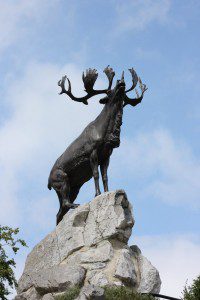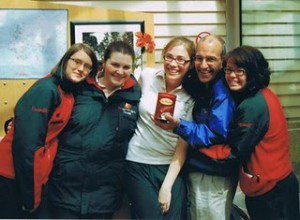 As a Newfoundlander, she pointed out that back home there are two important observances on July 1.
As a Newfoundlander, she pointed out that back home there are two important observances on July 1.
Each year when the first day of July dawns, Shandel Leamon explained, Newfoundlanders mourn the events at Beaumont-Hamel, France, in 1916. On that July 1, as the Somme offensive began during the Great War, British generals sent hundreds of thousands of Empire soldiers over the top against an occupying German Army. In less than half an hour nearly the entire 1st Newfoundland Regiment – 658 men – became casualties.
“A span of two football fields,” Shandel Leamon explained, “took two months to take from the Germans.”
But then in the evening each July 1, the young student from Little Rapids, Newfoundland, pointed out that she and her fellow citizens celebrate joining Confederation. The island dominion formally became the 10th province of Canada on July 1, 1949. The evening therefore turns into a celebration with promenades, parties and, of course, fireworks.
I met Shandel Leamon and her co-workers – all Canadian university students in the employ of Veterans Affairs Canada – earning tuition money this summer at the Beaumont-Hamel historic site in France.
I had come 6,000 kilometres from Canada and met some of the proudest Canadians I’ll find anywhere. Wearing the VAC uniforms and full of stats, stories and history, they seemed devoted to their work.
Often, however, Canadians are not that distinctive in a crowd. As a nationality – a distinct population inhabiting the northern half of the North American continent – citizens of the “great white North,” can sometimes be hard to discern. So here, for the record are some of the traits that might help the uninitiated recognize me and my fellow Canadians.
Canadians are familiar and (for the most part) comfortable with extremes – cold weather and hot; Pacific and Atlantic Standard Time (a half hour later in Newfoundland); lotteries and the Goods and Services Tax.
When they assemble for sports, Canadians can be just as comfortable slipping on skates or skis or runners; heck, they’ve been known to play baseball while there’s still snow on the diamond or hockey in July.
They have holidays when most others don’t – such as Thanksgiving in October and Family Day in February. But so have they taken a regular holiday, such as Victoria Day, and made it their own – the May 2-4 Weekend (as in a case of 24 beers).
The world can recognize Canadians because – unlike the rest of the world – they’re blasé about such things as Niagara Falls and the Rockies, Celine Dion and Don Cherry, maple syrup and back bacon, sundogs and the Northern Lights, sunburn and the wind chill factor.
Of course, Canadians can be outed by pointing out the way they speak. A quick check of their pronunciation of “house,” “about” or finishing a sentence with “eh” are dead giveaways.
Though not as overt with their Maple Leaf flag on battlefields as say the British or the Americans, Canadians display them proudly on such domestic fixtures as bridges, vehicles, light standards and railings along the Highway of Heroes as a form of comfort, respect and consolation.
Canadians are the world. Most have come from somewhere else. They can just as easily be members of a First Nations society as émigrés from Europe, Africa or Asia. They can be found in churches, synagogues or mosques, or in none of those and still be accepted as spiritual. In that sense, Canadians are perhaps more like a United Nations than the UN is.
By the way, there’s one other uniquely Canadian trait. And once again I discovered this via Beaumont-Hamel student guide Shandel Leamon and her colleagues. At the end of our tour of the historic WWI battlefield, last month, I put a question to her.
“Do you get rest periods?” I asked. “Perhaps a chance for refreshment on a break?”
Leamon and her co-workers nodded in puzzlement.
 “Well,” I said, “my tour group and I have a little something to contribute to that break.” And I pulled from my backpack a taste of home – a tin of Tim Hortons coffee.
“Well,” I said, “my tour group and I have a little something to contribute to that break.” And I pulled from my backpack a taste of home – a tin of Tim Hortons coffee.
As It might as well have been the Holy Grail or a king’s ransom. Leamon, as well as Alyx Holland (from Brampton, Ont.) Sarah Aubert (from Trout River, Nfld) and Amie Hodgkinson (from London, Ont.), all began hooting and hollering and leaping around the information centre. They insisted on hugging us and taking pictures (an outburst not typical of being Canadian, I have to say). They told us we had made their day.
Actually, no. They had made our day a distinctly Canadian one, and one worth savouring this July 1.